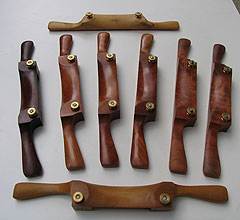
If you looked in on Russ Filbeck at any point in his life, you’d find him dividing his time between water and wood, but halfway through his double career, he made his vocation and avocation switch places. For 23 years he served in the Navy, and woodworking was his hobby. Then he spent the next two decades with woodworking as his day job, and sailing as his hobby. One way or another, his life has been a balance of water and wood.
“My first career was wonderful,” Russ recounted. “I went into the Navy five days after high school graduation, and soon got the chance to go onto submarines. There I found a very tight-knit crew, just like a family. There was great esprit de corps; everyone relied on each other. That first WW II diesel sub was the best tour of duty I ever had. The others called the sub crews ‘sewer pipe sailors’ because of how we smelled. We only showered once a week and were at sea two months at a time, but we were all in it together. Eventually I served on nuclear powered subs and rose to the rank of Command Master Chief of the West Coast Submarine Command.”
Along the way, he got married and had two daughters, and the woodworking bug that bit in high school reemerged. “I had woodworking classes in high school around 1960 and liked it. I started woodworking as a hobby in 1968 right after I was married. I needed to build some things for the new house and new marriage, so I went down to Sears and bought my first table saw, a 12-inch Craftsman. It cost $250, which was a lot of money back then. I got the saw, a dado set and a molding head. I still have it, and still use it.”
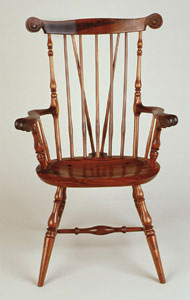
He retired from the Navy in 1985 and went back to school, this time at San Diego State, to get his bachelor’s and master’s degrees in industrial arts. “I had a very poor high school education growing up in Missouri,” Russ recalled. “I didn’t like school and only ever planned to be a farmer. I liked woodworking well enough as a hobby that I thought I would also enjoy doing it as a second career. While I was in school, I started a furniture restoration business called ‘Wood it be Beautiful.’ The sad thing was that while I still enjoyed woodworking totally, I lost my hobby, which had provided me with a mental health break. To make up for the loss, I started sailing.” In a sense, his hobby and job simply switched places.
“In 1984, I joined the San Diego Fine Woodworking Association, the largest woodworking guild in America, and became president in 1987. It was during that time that the staff of Palomar College approached me about teaching a beginning woodworking class. I started teaching beginning and intermediate furniture making, but my second year there, they asked me to start teaching the finishing classes, since I had learned a lot about it from my restoration and repair business. I created a finishing program at the college, including both a basic finishing course covering preparation, grain filling, choosing the finish and rub out; and an advanced finishing class with crackle, faux bois, glazing and all the other finishing techniques.”
Although he is now a full-time teacher at Palomar, he still owns his restoration business, which he says is currently idle. What is not idle is his favorite area of woodworking: building chairs. He builds only Windsor and Appalachian ladder back chairs and teaches a class called “Classic American Chairs.”
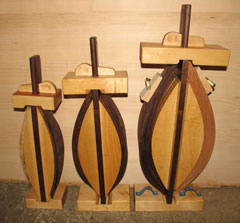
“Each summer I travel back to Kentucky to harvest green wood and hickory bark with Brian Boggs,” Russ explained, “so that my students can make chairs. We need straight grain green wood split from logs for the body, and the inner bark of the hickory tree for weaving the seats. Mostly we use oak, walnut, cherry and maple. I haven’t kept track, but I typically make about 15 to 20 chairs per year. As the class builds a chair, I build one with them. There may be four different styles of chairs being made in any given class, and I will build one of each along with my students.”
Chair making led to his redesigning the traditional wooden spokeshave. “I moved the handles to the bottom of the body instead of at the top, which is much more comfortable in your hand and on a shaving horse. It puts your hand pressure in line with the cutting edge on the blade. I teach how to make them at the college, but I also sell them when people ask for them.” He lately made 25 spokeshaves from a cherry tree that was taken down in 1972 on his great-grandfather’s farm. “Each of his descendants will be getting one,” Russ explained. “My uncle told me he remembered seeing crows beneath that tree getting drunk from eating the fermented fallen black cherries.”
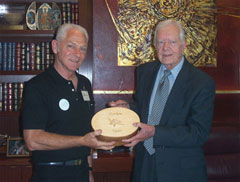
Recently, he has gotten a lot of press coverage, complete with photos of Russ standing with former President Jimmy Carter, the recipient of one of his beautiful chairs. Even that came about because of his desire to share his knowledge with others, and his propensity for offering gifts.
“Two years ago, I decided to write a book about making ladder back chairs. I wanted to include a section in the book about current chair makers, including President Carter. I had seen articles in magazines about his chairs, so I wrote a letter to the Carter Center, his world charity organization.” Russ landed a phone interview in July 2004. The two, both Navy men and woodworkers, soon found they had a lot in common.
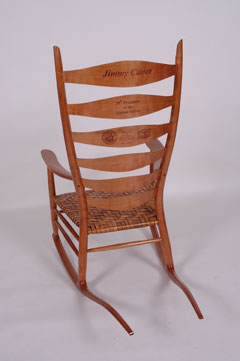
“Carter told me all about his process, that he was self-taught, and that he used some of his great-grandfather’s chairs to study how they were made. I offered him one of my spokeshaves, which he accepted, and he agreed to write the forward for my book. The book, which is soon to be released, will come with eight hours of companion DVDs covering the process for making ladder back chairs. I asked Carter if he would like to have one of my rocking chairs, and he said yes, so I made one and delivered it to him in June 2005. I had the slats laser engraved with the presidential seal and his name.”
“When I delivered the chair, he signed two of the books that he has written and gave them to me. In one of them, he described how he sold one of his chairs at auction to raise money for the Carter Center, something he does every year. When I read that, I offered to make a second rocking chair and donate it to the 2006 auction for the Center. It sold at the auction for $6,500.
A persimmon tall cabinet that Carter made for that auction sold for one million dollars. Both pieces were bought by John Moores, a venture capitalist who owns the San Diego Padres.”
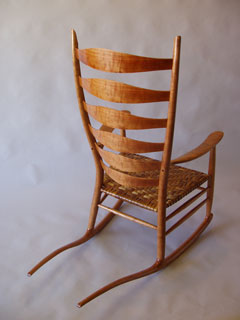
Russ also built a rocker for the families of the New York City firefighters, which he sent to the New York City fire commissioner. “I told him I wanted it to be used, not displayed, so it is now in the Cornell Hospital Burn Center, and is used by visiting family members of burned firefighters. I also made one for the Pentagon families, which is now in the Pentagon museum for museum visitors to sit in.”
With all his giving, his most important charity is still sharing his exceptional skills by teaching others. “I want to keep our forefathers’ skills alive by teaching others what I have learned,” Russ admitted. “I want to help people to develop high self-esteem with their creativity, so I advise them ‘be free in your design, and be yourself.’ I want them to feel good because of what they make.”





